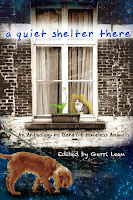In addition to some favorite Halloween-themed fiction that I've read recently, here are my favorite stories that I read in October.
As an aside, I'm up to almost 400 short stories read this year, and I'm not even remotely getting tired of my one-a-day goal. On days when I'm pressed, I can always read flash, after all. And I am always interested in hearing what stories my friends have read and liked, so I'm getting great recommendations that way.
"Virtual Blues" by Lee Budar-Danoff
I've seen a lot of stories that deal with "wired society," in which people interact almost exclusively via virtual interfaces, but I think this was the first story I've seen in which some people's bodies simply reject the implanted interfaces in spite of anti-rejection drugs. And if the rejection doesn't happen immediately, a person may quickly get used to being wired, and then have to live without. Can you imagine your life without the Internet now? Probably not, or not easily, and this kind of "wired" goes significantly beyond what we have today. Imagine the eerie silence of a crowded public space in which nobody is interacting with anyone else who is physically there.
But what makes this story special is that it's also about creating and playing music, and the bond created between a performer and a live audience. I found it quite moving, and I felt like the author completely "gets" jazz, as well as music and performing in general.
Published in March 2015 in Diabolical Plots (read here).
"James and the Prince of Darkness" by Kevin Lauderdale
This humorous "deal with the devil" tale shows that sometimes, it's all in the story's execution. James, a Wodehouse-style valet, proves very resourceful when he learns that his employer displayed a serious lack of judgment whilst drinking at his club the night before. This story's tone is pitch perfect and wonderfully consistent, with some truly funny lines.
This was published in Third Flatiron's 2015 anthology Ain't Superstitious, and is available for purchase here.
"The Demon of Russet Street" by Jessica Reisman
This story, at about 5,500 words, is so incredibly rich that I'm experiencing world-building envy. It's slightly steampunkish and slightly godpunkish, yet filled with other little odds and ends too -- I loved, for instance, how bits and bobs from the sea were incorporated into everyday life. The story follows a farrago named Rusk, who was bequeathed autonomy and wealth when his deviser passed away. Rusk is asked by the authorities to look into the "disassembling" of another farrago -- murder, really, but under the law, the only penalty for someone who destroys a farrago is compensation to its owner. The author incorporates magic, some amazing technology, and creature rights in a way that made me want to see a lot more stories set in this world.
Dare I say that I was even reminded, flavor-wise, of Ted Chiang's work? And that's not something I would say lightly. There was just a sort of fearlessness in the world-building, if that makes sense.
Read in the September 2015 issue of Three-Lobed Burning Eye here.
"Every Other Emily" by Joseph Sloan
Published in the September 2015 issue of One Teen Story, this mainstream YA piece consists of Emily's e-mails to Paul, who has gone off to Yale. Emily vents to Paul about the $600 per hour IQ coaching her parents have forced her to take. They want her to get into an exclusive school for a "gap year" after high school graduation, all so she can get into a college good enough to be suitable for their lifestyle. Emily also writes about how much she misses Paul, and says that he represents the only thing she ever decided on her own that she wanted.
This is beautifully written. I wasn't surprised at the turn the story took (although I didn't know what the details would be), but I was satisfied with the resolution.
I also want to mention again how much I like this publication. One Teen Story publishes a single story per issue, delivered in a little print chapbook. I've read eight issues so far, and I've rated half of them at 4 out of 5 stars or higher, which I suspect is a much higher average than I get for most other publications. We all have a limited amount of money we can spend on subscriptions, but this little magazine is one I really look forward to getting in my mailbox each month. It's an offshoot of One Story, which has the same one-story-per-issue concept, but has a much more adult literary feel. I like One Story, but it's much more hit and miss for me than One Teen Story.
Available from the magazine's website here.
Other stories read in October 2015:
(alphabetical by author)
- "A Marriage" by Kiik A.K. (original 2014; reprint 2015)
- "The Great Old Pumpkin" by John Aegard (2004)
- "The Half-life of Chocolate" by Nancy Fulda (original 2011; reprint 2015)
- "The Last Book" by Guanani Gomez (2015)
- "8 Steps to Winning Your Partner Back (From the Server)" by A.T. Greenblatt (2015)
- "Possessed of a Fierce Violence" by Alexis A. Hunter (2015)
- "Genie From the Gym" by M.K. Hutchins (2015)
- "Message from Beyond" by José Pablo Iriarte (2015)
- "Something Wicked This Way Plumbs" by Vylar Kaftan (2007)
- "Dis-Orientation" by C.I. Kemp (2015)
- "And in the End, They All Lived Happily Ever After" by Michelle Ann King (2015)
- "Spirit Board" by D.J. Kozlowski (2015)
- "Crystal" by Ken Liu (2015)
- "The Devil Is Beating His Wife Today" by Sandra McDonald
- "The Cats' Game" by Michelle Muenzler (2015)
- "The Burger Bargain" by Wendy Nikel (year unknown)
- "Bloody Mary" by Norman Partridge (2013)
- "When the Circus Lights Down" by Sarah Pinsker (2015)
- "The Mirror Man" by Andrija Popovic (2015)
- "Summer in Realtime" by Erica L. Satifka (2015)
- "Super-Parents Last All Childhood Long" by Erica L. Satifka (2013)
- "The Librarian's Dilemma" by E. Saxey (2015)
- "Night Witch" by Shawn Scarber (2015)
- "Bump in the Night" by Linda M. Scott (2015)
- "Stalked by Night" by Michael Seese (2015)
- "The Terrible" by John Wiswell (2015)
- "The Grim Rufus" by Peter Wood (2013)
- "Have You Heard the One About Anamaria Marquez?" by Isabel Yap (2014)
- "Grim Hunter" by Tina Yeager (2015)
List of the sources from which these stories came:
(alphabetical by anthology title, magazine title, website name, etc.)
- Ain't Superstitious (anthology), edited by Juliana Rew, September 2015
- Daily Science Fiction, various dates
- Every Day Fiction, various dates
- Expanded Horizons, October 2015
- Fantastic Stories of the Imagination, July/August 2015
- Havok 2.4, October 2015
- Nightmare, October 2013; March 2014
- One Teen Story, September 2015
- Page & Spine, October 2015
- QuarterReads
- Shimmer, Halloween 2007
- Strange Afterlives (anthology), edited by A. Lee Martinez, 2015
- Strange Horizons,
- Three-Lobed Burning Eye, September 2015
- Uncanny, March/April 2015
- Unlikely Story: The Journal of Unlikely Academia, October 2015
Read more!






























